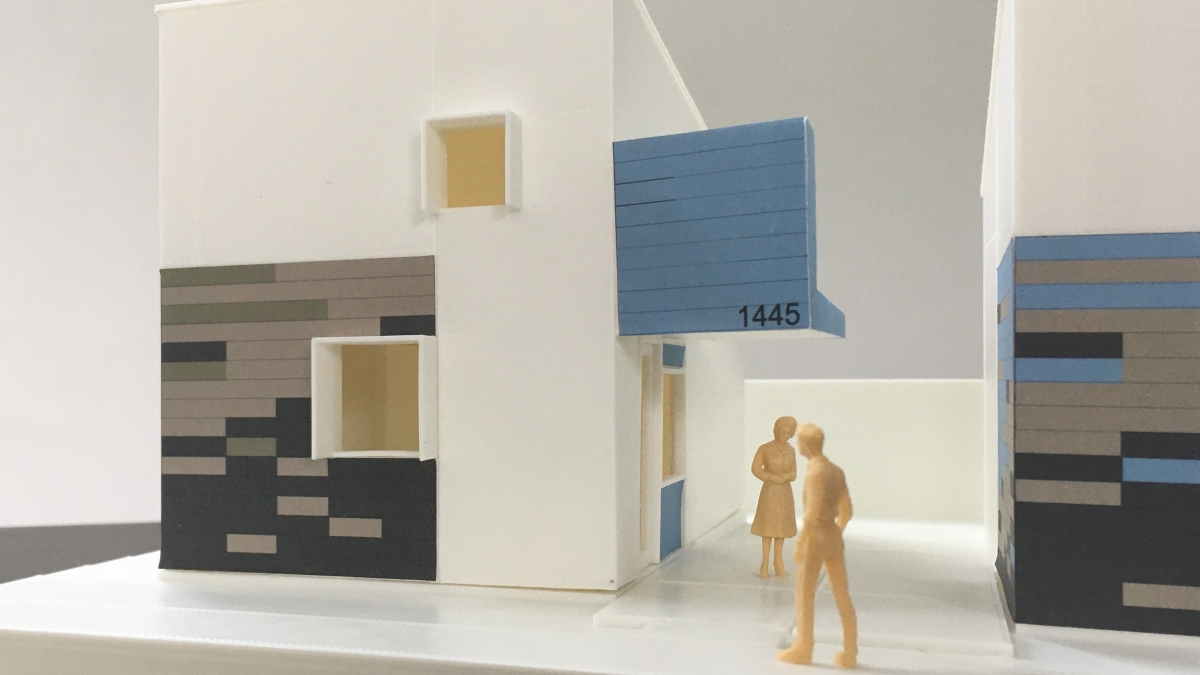Small things often amount to little more than what was originally put on paper, but in the case of the Micro-Estates development on Rita Lane in Tempe, a seemingly small Arizona State University student project has made a tangible impact on the lives of hardworking people.
In fall 2015, four students in ASU’s Engineering Projects in Community Service Program (EPICS) started working on the “Humble Homes” project. On Feb. 20, Newtown Community Development Corporation had a groundbreaking ceremony for the Tempe Micro-Estates — a “small-home” project on 0.66 acres of long-vacant land where EPICS students first proposed their project solution.
The city of Tempe’s development services Director David Nakagawara (retired 2016) proposed the project to former EPICS Director Scott Shrake in 2015. Ira A. Fulton Schools of Engineering students Anna Brophy, Ana Lopez, Ana Repta and Brandon Hew took on the project in the EPICS lab course, researching small homes and potential restrictionsTypes of restrictions could include environmental, social, economic, land use, zoning, and utility. affecting the site. Through the fall 2015 and spring 2016 semesters, the team engaged with Tempe staff and residents to create design specifications, schematic site plans, community living parameters and rough cost estimates.
The team was encouraged to consider the three pillars of sustainability — environmental, economic and social issues — in their human-centered design concept. In response, features of the students’ project included community garden space, a community activity center, shared open space, gray water systems, solar electric generation, 11 energy-efficient dwellings (ranging in size from 300 to 600 square feet) and one parking space per dwelling. With an eye toward community living, students considered how residents would govern themselves, make decisions and resolve conflicts — all of which are now covered by the Covenants, Codes and Restrictions that apply to the Micro-Estates site.
Micro-estates design courtesy of EPICS students.
During summer 2016, students presented their ideas in separate meetings with community members, Tempe city staff and city council members. Council members Lauren Kuby, Corey Woods and David Schapira endorsed the project as a possible workforce housing solution or alternative housing for downsizing senior citizens.
In a July 2016 Arizona Republic article, Schapira presciently said of the student’s work, “I think this is a reality. I don’t think this is far-fetched.” CoLAB’s design for Newtown’s Micro-Estates project closely mirrors the EPICS team’s vision.
The Micro-Estates site has 13 energy-efficient, 600-square-foot, one-bedroom homes designed to be low-maintenance and use locally-manufactured materials for construction. The units each have a patio, “kitchen garden,” and access to a 900 square foot community space with community kitchen, gathering space and laundry. Each unit has a single parking space and easy access to light rail and bus lines. Other site features include edible and/or native vegetation, rainwater cisterns and outdoor gathering areas. Kuby said that an agreement to build a solar electric generating array on site has been negotiated and will be part of the final build-out.
Homes are only available to first-time home buyers with incomes lower than 80% (and up to 120%) of the Area Median Income (AMI). An AMI of 80% is about $41,000 for a single person and $46,000 for a couple. Home prices are estimated to be $160,000 to $180,000 for 80% AMI buyers and $195,000 to $215,000 for 80% to 120% AMI buyers. By comparison, the Zillow home value index notes that the median list price of homes in Tempe is $315,000.
Written by Paul Prosser, the project partner liaison and an instructor at ASU’s School of Sustainability; a senior sustainability scientist at the Julie Ann Wrigley Global Institute for Sustainability; a former faculty associate for many EPICS project teams, including the Humble Homes team; and a registered architect with 35 years of experience.
More Science and technology

4 ASU researchers named senior members of the National Academy of Inventors
The National Academy of Inventors recently named four Arizona State University researchers as senior members to the prestigious organization.Professor Qiang Chen and associate professors Matthew…

Transforming Arizona’s highways for a smoother drive
Imagine you’re driving down a smooth stretch of road. Your tires have firm traction. There are no potholes you need to swerve to avoid. Your suspension feels responsive. You’re relaxed and focused on…

The Sun Devil who revolutionized kitty litter
If you have a cat, there’s a good chance you’re benefiting from the work of an Arizona State University alumna. In honor of Women's History Month, we're sharing her story.A pioneering chemist…



